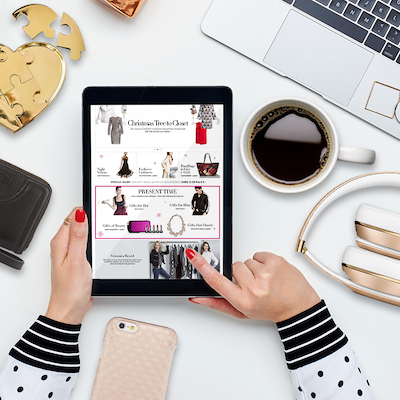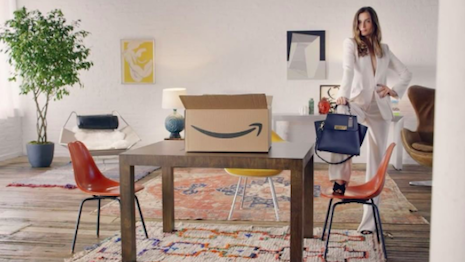Most consumers have returned fashion merchandise bought online in the past year, with common causes tied to fit issues and a difference between ecommerce imagery and reality.
According to a new report from Yotpo, only 12 percent of shoppers say they have not returned any fashion merchandise in the past year. Returns can eat into retailers’ bottom lines, but providing enough context and information through features such as user-generated content can help consumers anticipate what to expect.
"UGC can definitely have an impact when it comes to cutting down on returns," said Raj Nijjer, vice president of marketing at Yotpo. "The user reviews and photos are key here, especially when it comes to product quality and fit.
"Shoppers trust other shoppers when they read reviews about how items fit, and it's even more powerful when the review is accompanied by a photo," he said. "The same holds true for quality. The feel of fabric, intricate detail on a product, how well-made it is are important to shoppers.
"No one wants to buy a garment that's going to fall apart in three wears, even if it is cute. Reviews and photos can open shoppers' eyes when it comes to quality, and photos help demonstrate what's great – or not so great – workmanship."
Yotpo's report is based on a survey of 2,000 U.S. consumers who do at least half of their fashion shopping online.
Curbing returns
The ease of ecommerce returns has led shoppers to buy beyond what they plan to keep. Two-thirds say they intentionally purchase with plans to return part of their orders at least sometimes.
Buying more with plans to return merchandise could partly be due to wanting to reach a free shipping threshold, which 88 percent of shoppers say they have done.
However, this tactic is also driven by uncertainty.
Fit was the number one reason why consumers return garments, with 79 percent saying they have sent back at item due to sizing or quality. Part of the reason why consumers overbuy is because they purchase multiple sizes to see what works.
Helping consumers make confident decisions revolves partly around word of mouth.

Consumers shopping for fashion online look to reviews for guidance. Image credit: Saks Fifth Avenue
Ninety-eight percent of shoppers say that reviews are an important factor in making purchase choices. Additionally, 66 percent of shoppers look to reviews for clues about how an item fits.
Retailers can encourage feedback on sizing by including ratings, and Yotpo suggests that stores include all reviews regardless of whether they are good or bad to help give a clearer picture.
Another reason behind returns is the gap between product imagery and how it looks in person, cited by 49 percent of respondents.
Similarly to how written reviews can have an impact, 93 percent of consumers say that being able to see shopper photos is important to them. Additionally, 72 percent consider customer-created videos to be important.
When brands do not offer customer photos, either through user-generated content galleries or reviews, consumers often will do their own research. Forty-two percent have done online image searches for specific products to see how they will actually look.
Having these features on a brand-operated ecommerce site is important, since 71 percent of consumers prefer to purchase fashion directly from a brand’s Web site.
The brand Web site is also an important step on the path to purchase, since 41 percent say they discovered their latest purchase while browsing a brand’s own platform.
Along with branded ecommerce, 48 percent say they got inspiration from social media. This is even higher for millennial and Gen Z shoppers, 54 percent of whom took inspiration from social media.

Shoppers take inspiration from social media. Image credit: Neiman Marcus
Similarly to product decisions, the discovery of new brands leans on word of mouth, with 85 percent of shoppers likely to buy from a new brand if their friend recommends it. Six in 10 consumers say they would recommend brands to friends or family, presenting an opportunity for labels to incentivize referrals.
In other good news for fashion brands, 65 percent of respondents say they are loyal to particular labels.
Rewards programs can help establish and build even better relationships. Ninety percent of shoppers would enroll in a loyalty program for a brand they love, and 93 percent would be more apt to shop with a new brand that has a loyalty program in place.
"Consumers are king and they always want, and even expect, a little something extra," Mr. Nijjer said. "Amazon shoppers now have the option to earn $5 dollar credits every time they opt to delay an order, and free shipping is the norm.
"D2C shoppers are no different," he said. "Ninety-three percent say they are more likely to buy from a brand if that brand rewards them with discounts, VIP access to products and deals, free shipping, etc."
Ecommerce outlook
As clothing becomes one of the fast-growing sectors in ecommerce, consumers are also shopping online for apparel at a greater frequency.
According to the 2019 U.S. Forecast on Apparel Shopping Trends from Elite SEM's CPC Strategy, the majority of millennial and Gen Z shoppers are purchasing apparel from ecommerce giant Amazon more than any other Web site. While many luxury fashion brands have steered clear of Amazon, the platform is becoming a bigger player in apparel retail, particularly among younger consumers (see story).
Revenue in fashion ecommerce continues to increase across devices, despite consumers actually spending less time shopping online through briefer mobile sessions.
According to a new report from ecommerce platform Nosto, the average revenue per visit (RPV) increased globally by 33 percent on desktop and 38 percent on mobile from the beginning to end of 2018. However, online fashion shoppers still spend more time browsing on desktop than mobile devices (see story).
"The real opportunity for luxury fashion labels operating their own ecommerce store is that it provides an essential foundation for creating a community of engaged and loyal customers that keep coming back to support their brand," Mr. Nijjer said. " Additionally, if a luxury label doesn't have a direct to consumer ecommerce presence, they are doing themselves a disservice, as nearly 71 percent of consumers would rather buy directly from a brand online versus via a third-party retailer."
{"ct":"IsH07X94YwU7I4EkDanep2Uq03JMWBY61OAO7KAls7VkgPs05eItsX+WDLwql3+kiE+oQvoAP0NSlATZrkuWV43pjOjKsgNQnHymTYQObZg6G6YQOB2tmmXykk\/GilVwuyKXmlOKNdVLYmKpwjFfoTpOlVI2Ujoh5uYWVmAzcYgMFl\/M4SESsmAHW1WxrRG40uKdooyYmbqfhE04IEqY+omKpR1nLaPYfJ2lAr1WkOi7Zz2M3F4ugew28\/+27sRDQFh6dFgqK07KHCG21k2RASKlxInENpRJhPZMZVLAGFNawsIrQzxBfNWzpd56pS\/HKEcA9CzGPtxUWrcTmoMXVUV89iA4MlPMV0lmAdd2uLxPFLfAPq5wHsqYIxyG9oP1IGJDUVetrnySN734gimE9auIea0yZ1d\/b5\/dSJCMBBclpf4SFIL2seGuAp2YvLt4h1i3ogHED10I0pquEo\/MO7e4bAYaosfHrvCRfC4VVJEDmlYyUuBql+QvP7m3R4AyCDrKILCMaTe1FQYpxtx\/UNF8AOX5sXrNADghp8Z\/C2A82SKqzRm92FodYW\/kCqMHWh5gRcWQmz4jQGq1G+jE4B28fwrdZR9e+tBQe9cETplmCSu6N18r7dzr6DPODn0dbMmVbTlQtitZBoTQi+qqM\/bbdD01QClaU0dDtNvaJKN7gclZuZqYBXt9D\/u3b9QehgQDLZjgDrFEv+U7A+Oa5aaRII0lwk5bgFg5zMbwrk6xNJlHK62od5JW0207P4+VgaFjCZw\/N1Rtq1gaKtn4SXTUiOvGym0D6wOGOQd12E8zVRRfRNJTwpEz4R5dYNB48YnrP6Ehi0Q8mC6+r8Hy4DPNJ0BtPLRCJQ5RrWdQ8y8YzIfTTKSI4DnJPVEGkLsKI+eFon9XUCsXKHhQ7LdrmwFH0bkMHfcLnkAfMolQQ4x8LM7DP9XvTaO5NccxePjskDNuoJiZHuvQoRkrctF0o5UF6hj7rJUmByCbMxIyXRuwL7MSPdqlgsaHBUgBXtWAdl7eNQHmRU+s4GKQVQdLZ8XCMChixV6\/NMq+ZJP7pnU2IPTxFDFFUaXhF0r9z+6o9UvDhHIPXAgO8tVDlM3pRJXQEcUFPljVUSv7iOzveUtjq8LGsRaiRZwM8FiMap0MhmED7KF2YTlZGWbaT8E3Fri0Zq0qeokiFWlchhHdH5DMZXQRXGLGumYXdTtH1Mg+d0e5bFrUqAAfwtij1Fl9N4U1X25E2RNxBQZFbUrLbAXnLdwkago657OOOz++osQo6cdDZcfSDOiHvec+VcvT0Cx0W2VZ2F0x95cZvcSSqHYcdMJENkZCOlS6VHtj\/CbVUU1OldxSn1XxEEYLyzHp5Ibo4aGXNsIXbuyOd4xby50gdMH0rR3n3eDmVldjzPEjTYr18qxsP5ynsVv77sy57hbh7QCXt2wAGZvuTliHtnAQhECPBVx0QQCgdXQ8lzgiIYdS\/TFAGMMh5sHiRvTKboNQIdit6kxyJljtYLLu128riaOHQ9w+Z3ercMoB+D6tRxc6xndHIyyd\/SCj7W1sqcRrTgnZCZ8LOflHJ1h6w9rEHS9Q8pNHxpdjnll85H+\/Mi15AAzfQYvxE9FFkXn9ZLiZ40KLOCrBYUFY9kR7xplKRs050YhmVQidMpSfPQSXFAxhm6ROycTqscM1hXwp+okrXgHHOt2W7NDdu5SQ8wjvQCziZUKuAABUmeLtmGWk4AsjJmsodjWFOyIr7dhJA4N\/KEnUE0YcmOgfb56fReEuCY7SzRH5DbWj760mXYYXcsKHHlJEZIGBXKCQeINZUkYmyfky93wR9HkLS83G+cObH0FbEoRgi+M9Tefk+jLcoR1bQMOgCOXW4K246MTiceGNBSRtaQN4khKI3qXDRp9yAH+t8C8KCkz25pnJ5LgDBy6irh1tojC1XNPQzrSIsF+xS1WdxmON7Hrk\/xPZijTNC2do1cXQHTjsUMHuvwlrqwp12hyIl+NrYE3VCemh74K\/6GuJHuTOsew\/64YMDFOWKDCI931ITwWW74MXlaLyW2xQJcRk\/pOq7RPvo7mQITLK7vlIA7bDSgdUmK6VBRee6GAtK0XiTfgpq0d+BhXj2odc2\/RdYEsADsERYH73FBH+hP0pHNGIBq1a8fgFRDVjbLXEV6zG7V7m0aKTNlm\/yrFq4pXnf1DnY6RLY0XYZwUfmsQL0VsY8yXVaiD0YPwOgERistFXxGGGR1FAPDseA3\/XOW1WVB0+9YFyfJxa9FKznUQpax3BZ4OXs1epXS1LhAmqQDJ930q4+YrEnRi2VAzo94RaEUTllJoNPk\/BljPuI0+9D6JhtBjI2gqgwjD5UO6izP6xsPVrQOVUm0UnJmoJBY6ohHeRHis1HnxQtK4JkGCDcNtI546MBRFvLPD\/w1hTt4EZ9Ts9sEhKeMl6WP7q4ZBXVNfy+u1W3gQDZj1iGoTGiXuGs5tDWZriesYvAx4yztIA3YcuLysSUkyxa+sNJ7Iv7Y6YnNYs3RxM8O6oQC02j7TeYgVnvFmwhYT6dZUH4pyHHsGsCaPn8FsEg1KuAJkpO7nSK3dNtb+jawxFCjCky2V6dZQBI4CJpadOkZSXMd8EzpoonGCOOPv2QoLvYRnBHSyLs5u4QXK5kxz2Vw3hjuo6tH5lVZAvrfU1Lw3lUknokGDL3KBXfbDj5vmp71EHOz2CLylJOvOt3ODXt5kMKsMIapDGay85RvI3SrblsA6lO9fPCyQPIXf2QkuZIBdF8Jxohu7UTB8PRB9Ohr7FJFZcHO2DrIsVCzm83RjPI+RMrOou9\/VVVfwbHhQF9WHInfOKKJ7tl1WWfPMSjlqDgchSHgKkNmw4Bn5LsyubkJIgq6M592IYGwdxAKEdcZnGYJfo3Y1e9rokjbibTcZIo7xVenyPdwJY+Iut3g1rFLLMcI0UmGbMhntk\/ENWCRIP+9Hk5mYNc+IyNcP5QzR\/cKkcK2EJwlMLyXk0ZQMtco5fXP2o90Z0PDRSMETClSu1cJXcSE7bmhx9c9Orqom7n+gZD6WI4Q\/dd8tuAqxABk866gK+Bkl73tM8UtNzhr4oDl7yOj1dnp\/esAaI07HdjUAaUyTHRkwdEKBySW+N+8R+rEe3mYVuKqel\/l1l2Xci6AUwCdN9nNfP0XbJJKp++ZObUgBCR\/i\/YGHiX2pgtq3x1tK9VDSlger+6OutXoya7mypzsZJ51qso2Eo0+TGF3DQeNIGSSI4bK5OqxzO99HN1ou3UVyAbFSwM7ivEt6NfXY3+WhDiMc8k49AMkGOBhVaXAhBBUu7ntDcnsRucMUGdDXiCDBzxu4rlHpkABjDIUzi5MIkR16fwd0MIeAVchuVkBuZMZlYIzIn4u9wbbu4hUY5J1P427rVUa8tSuQQyQtSqxHDfAI5T9qF\/H\/ayu2HJmSdc4UPeXa6mDc1kR+cuAx+em6FbVxABSGkolfmS4mbI6qTwZHV04MHMbomXsPKA9y3GyWKdlwQy8qGx+7r7VD7\/OZUw3uJHJhAaHPe624He\/qnuwlwXYtc7X51jnhHfVgkfGt4SUbE+ABJjtI7O6ndCWzsvxgrak7sjlq2D9+cx1Wuw+nvusWlQS5HgU4GRLFR+ijEwFf5MZexARX4\/rmKPpUTBwLJMysaun7riDKIfbrLFTiuNc3azWmpPl6VXnpL1po0UVRFoptF0QpQ1qMjKKJEXgghrsoNs3mi0ubUtX+SS+X0Uuni8qUPKMMdjSzTkN16s6zR7Iumdw\/lnbaBuB\/3vYDdD4wW6IrV6VSf1j6XDXgIPUSDUQf6FEfR3G59XOHbmyjm5wirxsL24RtKNTa7W59dQt8cHJbRAB6CIwhZiToDa9aQhPJyHnsiYFYZLuK5S6nJydyYh+2xp8POgRGwieFFQK7b\/N5Fg6TqYu3r1fmhscjXa9oW4DnHmMc4\/crsS86kVLqZJWJ4+2Jgx\/IDS5AaYbnREEloIPE3s2CtzceyJWvZUKuiwJ0xp3xHUkda6iKb0ODRN43uj\/CxjLgyUkJIPQHcztivVyp4hxX1te\/tEamSOtpf80JUm\/2v1bgaeZAVh\/Y9KlxFp9MeeIkIQLzbJUiDP90jmvGMyShDSl5whrP+saJx83dDAdfhWx6nV+XCYDJKdld\/AKd2+X4sinS4dAwV6becU06CIfUOPn8c4cn5nOWvqINGCIzuiE60i1uBjLQPdHaNFBFrZ9rFj1bqJ96qGDKP6jEFlPDuXcU5PM1pcFYUVWSvEIDx4Oe1JHe57A+MMz\/rg7qG\/PHDidbwNFc\/vb1zY+oVO16GiuOmhMArmVTUhGQTiIElXdhDeLtGZ+1cteWP5xSDQOLNqnN+cnrEMGWiT3XdeeZ+ePx2US2M+T9caStgQaq+JLbzUVqS+jcKDlxzrKJs9AoE9Ad+sI9bSyA6nz\/KLdW887ysO8EfnlaoCvMpg2X843hKaLpi0Ibzho1PfKAE9L9I14QOdc4AxUfMaX+KL8mhLDV9qUFh6F3XnvyqvL4sxPqdV86KiTjhkd2jJuFt4Cm\/DINVXe0qk3HAWJ5+wi88Sy1opLXE3akqWFkqOzsUJkUxqH\/cXbBbIJgQlgGFIvf7SefoROVQJ7afnpU9tBPUuXcODWVMQth3E3KJl\/yK+cSdDCRCUygW9YPz7bOiO0iZESZWGTR2tTcRx7neO6UKanBo4LMnRBfVYDZaVtXyTdVOIbtmEOVcCMIySTgcjF4MOpmKuteu13D8RzAgdndtiB+fHMJuQ0684QkF9UtCLWm\/MM9tNa8Pkym0FOoF5uzsPR6qZOnnmBspazyZKK7SA1M6GXDcLPpIB7nO3FQK5ySVisNGb71xwctNCbqTgSqHKXwqZMrIhHs\/NR9eODEu6h5GZL8J3M1iO7s3eRoOHfQNgH4X8Ez23JDMFf7QsNUYMugFp+j4WvG5iSNPzJXVvFxL0Glse4oA5j3ubvSMurC\/Ur3DtX+FkMGoZzHSP+dvjywk\/IJD5DQG8V3fLbr6B4djvTKWOQEbzf84qahQRfGNrrQZc60hW+cDEOQ6GzRGWNBzfvZIBG9o601uPwm\/N7Q+rhzqL5lkIkFgcifYZrG+kVj15arKoDm0ZWAkhQ779S1cuc4P0D1oMMU\/XC7KLNrLGvI9Djiq88hIop\/IUsi12gaA5L\/oebURFlu9aODoeFY9ooOYMFh5GKPdLyLvJKZQQw33yPw8azFcUmdVmWZtAgpqhn7oVX8+ods5adjjKwg9lUgsu9mh\/UZwWE9NRyhoGKKMDANW1SJD\/Iucaj91mPBy\/gkElzqchGj3PW4Vz60b2Ef4voB5csvvCIUvN1Mx70Zf38kgPOADCN2p5Zoy5SzokI8TM3PTCkDyuia44vlSO+PZglyywSvmJaPkn5C7f4kSLlujW1ezo8KBb9a9I5xMOkybn9d8Psxt8wB60DPkgiYl3fi1bZcHzjL6oL+ThhqDQ16Pc4oR7Mcsb+MlxLJB8raROOqRVi6dqRnyuN\/\/S3+Rl9MP7oR6bp4HuSDjnca8enjr\/L+JlN9IIUWLhLsvWYs1q7ymADlyzpF0Hxr+ZV1rAyXQgnYcya0AK9jwC4uVfXTpPEy5LKFnAS5StUq9Uwux2wXDiszMF6P25j4eyBt8gdaiKHlXu6RHT+fh9BMQ2E3OOpJqQ+1e1hZVVStoXJmlcfCfJ8hun5rBUuEDnr5eSAKM2Q0ukUC39lFbE0Xx7KTq28B5JJjuVPLz4Q31iuXV944ZbAVV0hWud5JRW03JV5XKf1YV0GulxNuVHTbJ8TCimCCBk9oXz7E50yWXM04Q8cNBzSsby6sf9ADNTM+AnLdSLBmoKzpYX62+qRXwTF6L3uRUA1QdA6yGb2qW3UJsLO8aCfdaPMe10+AS78ffz4z6f5fAduf1aGDkfAcuJ3GZf0dishOG1z1xGNb3vxPXMV4S6DVKiXqi\/817lc0XQqSgHZqWIb\/9x7W7wPVMtqk0bPseTCadh+Xlkh2YOHcsUoXNKGxSp1+s2R5+VECoQf3tgVYFcfHmu\/C2q8tjexirCxjfg5Z8UB6e2VjbzlHh59e9OY6kkH4WoUx10A5\/9yyZBKvSzlj4GUb7ZmFvAOkGVDoBBVkoGBwFIUlFuvhBsF7x29EYozR8WZ2M0edyTpk0u\/99p0mlGw7a5zWecQvPzwUZGDH7GYisN1TzXUiRvtSXTfrZebps4OHwqvMtO6beTOvSzE1\/ZjWe3gkT+jANHFvs+UouwEgMp55vIA38Mb+ROHmB\/+1lN2w9GDffBZ+uWf9C9msyjeWy8\/+RpjoOXZ6KQr9260pUX3cYxYMukBfIPw8asAWPXOMnodmZi4BjeqIsPjCyL\/R98\/R7TdzuNAhJj+QYlbcngxy2NeyAuJQdVpz5ue0ciV6Hu4M0UqGpG6IEMnwZ5A0QDaNtXuS9MC7Y5CrAlRoH+eZT03HJ\/0Sj\/TtBK1racPUTM9WzOYW4VGztUoRETKDEqftzuPiC6shOxjo3jR8fX+VHL60srynCNRE0HloFmkEnX19JUeGfPVl8vjT2KYg9w6oXW7X43gS6q0gGCRFwjRZ8T3XDRYHNYtD4JBqnrGzR9JRjJo97LghCrgrmxPZKMSYg3VXtu193+\/BCdzzyjaU8v17W7FXcBgzrt7m0oqx1GlTykNhi\/RJFFchC4GgKaRBKv7mibYZqbKblEuYqK87L6p41MEDGqXWYEV6JlJIhFt0ewK7U80EcW+pDGQrnU5PEAYrjHTGT4qt4taLXDxBzCVYvK1CEnSBt2tvHLin\/O\/TL677LeGntfQBbyMm6ALk9DmYCwWlaknpWlXOdEWWtX7KIA6pPLaH7VqfFQEcpUYOBUb3jR8q8\/3RK\/My0n0pgxFDSaE46qpUY83ME62CkMG\/4uRtVwVA3b+4MGnEdS+68WdL4GWg\/zpINLX+bBHDw3AcVaTTGLOxv1DEz8L82\/dcSptqCpANqRrHNSyixwT+JpYuatWlHg8cNONDPOYVSmClEXlFaXWkVafHp7bi71kAA\/BwH39Oj6+yyCopn55uzsLhyeb\/jteffuoQlf\/WoiahuFFAMW5\/P4Mq1JW9hV6Na0tvUOkFImcjaUy05vBEW5tEsdsVZlaKbnujbs7L1Sju81wB7YO61xfPrIsMVzMm6v41afidWhko\/0gk9FN03\/BIrwbBGBPf823KsmQXtL6iiehFA93EtSuLXnsftTFoPPqoO72a7vq0ksphhOkTvXtlPQrBYDmTO9XAcvravGi3mJrTWH5oGxecPtzAq831FtLDezsEequw8s\/pRvTjfKneMwZBKP8wPkWkIgXJZpcWLCziC1X88TvH57yJURlT\/iMRcGiVfnsksRFTaXoY6OiMbZINE2bjLfg4LgYrxXXiZOOJfuPeixXMTQkWNH2EtAAsZ9AYY1e+8BqPFGoLj6T7At31JYzeXCbS4MUYg4Dk0Ccl8cjj40iHMuXiACkuoruo6hjIPv0pWbGgvpuKAj72aWeoWcq3l+2oMVhw94cLARuUF8D3wac1GopTard1YL77lRrO6uOYWt1VeZKenFNcz2aMYcHWvOtuZwU9AtW\/+BLKTfDESyAYSQThBlxGr3jqeXqc2JYhMwHx9FTPaXPJHYnTxDevcxUJMlI3U+OSV0Ldp2DFey0UGr8YLIoL1CbFErBLuqRBf8qGeOjzGr+r0filKNpzNW30NZPGQZfKxN5B+ExIel2MVtf0AE6qnXErsXej7TuV8+L5jHqeIRuFM4ChlKP26GMqH73\/EVCmWh3PPbUc\/CeEwMz0f1vesQ7u+gJFApX9yjL5LGlBkWo0kX9hHwJ2DGuFa5iLXpCuv9YFYZVTfz8GFNZeRLOq9icaLfLjuqN6+Erac6Puig6qRGWI6LoVy4CFp8nVQynjn1NGo9l2swwVH4OrEEbcMPIGcwQYTvqN7YyPX00Sh2ips4tfmC2Pp0l764\/itou5aL4TRvYubIQFk9HGSeZchGDinJsrKC9URxovsxhbdmCU0JC\/2ZgUdt6stFbf5vY8OzCqKSyyf+C\/0prqbBV5F5mvb1A0bsNjwJhnu6WaqkT7HZJax8o8X38nwHoAVC1mHnF3W2BvyUOOnyaUYtH1sRz8ECOnDb1DM\/yw1SnMhjmeCzFn398HOxD0rMlEMUPy\/lgfoVOXALNLPydW7q7r7bn3YlcAmAzMPL+tKrlQUPr2irLkma0HI0wCWacOO1IagA59qqFyA5vBXdb5AnrD3NX4VysExbbnzTL7\/oDWoPmSsBcGfgSnTItu08zLyBvkYe3OLILusMRvSVBhuDoMtuGxZaeQD\/pkLQwscWvB3jrUeaanF0gQ\/ln\/\/kjX+Bv0BJ8EcENyMQj2RzoHlzbjsH9AXobuec8fx3CIHxYxtVs4sKL3sEqCmVEV0jonCax2upIVRii2X7MHFmUc5jVYQYuGyXczj+94VDSJ+3H9uhp5mJyul6wggms9tAe3Mn2KPO\/i8AWtr\/9tqIQspPvWQNYhU4XhBsTiD6xT3iulQDrIkZqGN\/AZS3823r6HHwgSzV9tyGOlW5Zwj8PVpYrKI+e9Y1\/D5YadauY8\/DUuQ3LmZGFBdEe0ckOT0EI28idp\/GJX7s9CZaLAhJPi1pn1iqOHXXaxt4XHoHVd3OE0QD5Y6kkVObQ2fxm1R3R+iroS1bhlZmQ+SzOw4wT35rhkKI36LSDDUTm5lsVm3t\/efhkaITufw7l2cfX10H0querETAesE6+kFwdvMg7DpuFTaYWelVpcfyOHCRodXrV00w0A4BFStufBHwLb\/sqhZrKhvVQPDArIH2+n2Wcns+x0lbM5jcoT67LNdeekxxWbMNzQx7zyuiR2u8CPQwTMmLzPV6nFJqsiM\/l\/lcc8BpNkffHfVIQ1XHHsP3Nwrl5F3f4S0\/lck9mLL+Io29e5bSztZrwldBPS9sEMILO4UdNa68kQSzLJcq\/3XSs5x7jZ3avtVXZK7ej6gweehgKSYhIqDbYwjmIfZUpjWdZlSxuZLxcE3P6JugvrAhK+7FN5VwvmKF5yp4YN7u+nqsBLxFHwh6PKaCK5aVK4U9EjjRbsukFsKHCC+I5WiYZc1cEd+uh96hqY3gPjRz87F\/UpMDi\/1\/dTl6P7j6UAguGSEeHenfMWlPAT8dUFKYKHXUcbBr67xMdL0Hw6zXtAwtmS8XKDsHc1Vyt\/bzs0UDFlL13ETal\/DOnOdOcmoUe+MwhFQ4aDPnNTJdajsOh1xdUumnM8rqU2nSG5vA90JFONeAl1gs1bjCyG6\/XL9uAoBToxWmDFL0IZaOcZs34poODnf+4sTwnosDA0vPNHwx\/cwFAgToeHBZi+ILQLbd3uMYpBQeR+HL+O0tRFJfN5gZL98hMKauujQ2VsPtE2hM97piIW6sBIdhLyz+I1R9Zmy3taAvPAhrs6QjK9ZuVvIpCY8eCf747TGl8QpSSf3lgK2XsuGEPxe6+HC0TEA4gUTqjLvmIIAat6BeKgbiQNHJVMTYgBTMOKoaR0HGy\/rhVUgRa3ZC7DJfloPYrLbMQuHxXwvihSEDBJpL9TVDvQbZFPX2Kt1wqI1sx0IjGp83Fm5rogod6WmtbqywYUMQAqXLW3IIqy\/bbcmH3+4Eegi+sAla6sPCPe7ijL0rhSl24wJBWmyqIU5YmkIw3pba3NPKABhTS9VQrTvZGaR1efcAbkGSYd6DeGrE\/We7SLOAfFLhaZ6xIQcxNSv0tQzlvYKqvuuA4LUpjcJZZ\/lN43nMwH8Wb9p6WKxmoNMw0wZ8tq8s\/uxxU3GWabb76oXC+9xAT92EOblhBkR6aAHnUA475H3fQtYr6yI0Fd3BvgaOJADlYwlOzSzKnOIV0xLxEP1LeDDHFcAyI2UmG3HiQJRszCwuXB6kb\/QjCIA61wtandsw+3p9Zx1NeAVvRBwF4bDnjq9DB9SI0p0PLTz8ctbAc2S72bmxHCATAf7ZYJ\/EdRQk4g3vI+FY\/J+LRPVbvojH8ubdoQw70MQcH6xJ\/51M60MILnsPAB\/OEu7znZTI0aiizHuuOte0mrOQK\/nENi8Iuj3HVLcFu0nxlTsBvWyDhym3bIQcSUB9bLPY7U6UuVB3QTB0j1gmgMWbr878POiOuch9LSELuWOeYPbdpQNXn11uKo69Zm2jI+bANc8mUvhgGtGUkILNBg1pMGjGsGa5Suw9nNgq\/Ih\/kD0piOV85N+6rKWejmA5z3G+pXil2ijnPzS4H+\/rNNmOHtTyWIObl+7JJ8F5vKFKQODAJOdM1WAAloEhK3mwQS+2\/7JLUaA7ZEjtkrn7xZ2VmXvvl5F663pyCKZ6hOYxzFdTt8i61jklHOBtRnyirlwSyq9m0NYbkbDT40wJMhCK2Rezr8OLCTcrcN5OzLsLhPk2crFLzyKrlOegzacrO77zc5Bnf5Ff+QBGzsdXCpSGDli+9ak9kTkSbg7Rie\/TL96vZOzSb\/VWEGeamv4PAJVx86rca\/GIhhfhzeprj4TTAnDwOiQeM3DDkbGnvXhAUC9bFPLxYmmkMn42I6OlzRcRl8qR22lDZKArPfi3ilJJ5esw+LA3cj1atZ23ZW+NU\/n2ZoOvznz4dXjZcM4zwD5x+thp\/bsiRYIWmNi1frfMaeS4itbg3GMu\/0irekn6g1fP7q29zsey0yilRxrOjX18ea5oUzyEE2V\/++InJGgVv4ZnK3zKRwpu96D+KMgeiPqM8uNMJiuULckkWT6L8b2qq5ZcTM=","iv":"636d9cd34fb119c5fc655a205c07a1d6","s":"1da096720e90eb60"}

 Seven in 10 consumers consider Amazon to be a destination for fashion, but brand sites still hold a lot of weight. Image credit: Amazon
Seven in 10 consumers consider Amazon to be a destination for fashion, but brand sites still hold a lot of weight. Image credit: Amazon
Great article! Retailers and Brands should incorporate UGC into 1:1 suppliers reviews.
The first step is understanding the voice of the customer as to why items are being returned, and once you have that info, you can then take the necessary required actions to begin to reduce returns and track your “Returns Reduction” success